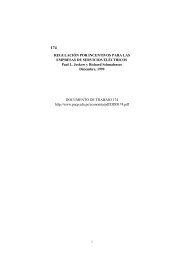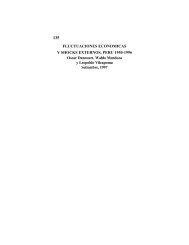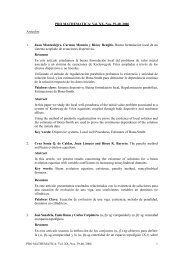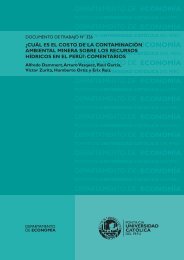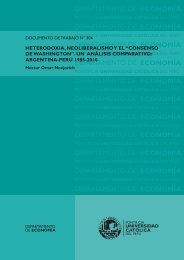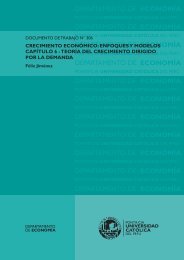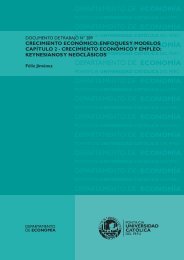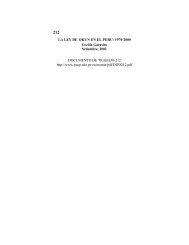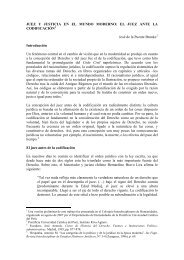CapÃtulo 5 - Pontificia universidad católica del Perú
CapÃtulo 5 - Pontificia universidad católica del Perú
CapÃtulo 5 - Pontificia universidad católica del Perú
You also want an ePaper? Increase the reach of your titles
YUMPU automatically turns print PDFs into web optimized ePapers that Google loves.
LA DEMANDA DE INVERSIÓN Y EL MODELO KEYNESIANO DEL ACELERADOR<br />
Fundamento teórico: El stock de capital deseado (K * ) es una proporción constante <strong>del</strong> ingreso o<br />
*<br />
demanda corriente (Y): K<br />
t<br />
vYt<br />
, donde v es el Acelerador, o la relación capital producto<br />
a. Sin retrasos<br />
La Inversión neta: si el ingreso crece, el stock de capital debe crecer en la proporción<br />
constante v.<br />
K<br />
*<br />
t<br />
K<br />
vY vY<br />
*<br />
t1<br />
t t1<br />
vY<br />
I<br />
t<br />
v<br />
t<br />
Y t<br />
b. Con retrasos<br />
El stock de capital depende de los ingresos pasados ponderados con tasas de velocidad de<br />
ajuste.<br />
K<br />
v(1<br />
)<br />
Y<br />
(1) i<br />
t<br />
i0 t1<br />
Donde: 0 1<br />
( 1<br />
) <br />
i 1<br />
( 1 )<br />
Es el coeficiente que indica el periodo de ajuste (va de 0 a 1 periodos).<br />
(2) Haciendo i<br />
K<br />
t 1 v(1<br />
) Y<br />
i0 t i1<br />
y multiplicándolo por se obtiene:<br />
K<br />
i1<br />
t1 v(1<br />
)<br />
Y<br />
i0 t i1<br />
(3) Restando (2) de (1) se obtiene K<br />
t<br />
K<br />
t 1<br />
(1 )<br />
vYt<br />
y sumando en ambos<br />
miembros de la ecuación el factor K<br />
t1<br />
,se obtiene:<br />
K<br />
K<br />
t<br />
t<br />
<br />
( 1<br />
) K<br />
t1 (1 )<br />
vYt<br />
K<br />
t1<br />
K<br />
t1 ( 1<br />
)<br />
vYt<br />
(1 )<br />
K<br />
t1<br />
(4) Inversión neta mediante el principio de ajuste <strong>del</strong> stock de capital (I i está relacionada<br />
positivamente con Y<br />
t y negativamente con K<br />
t1<br />
).<br />
I<br />
t<br />
<br />
K<br />
t<br />
K<br />
t1 ( 1<br />
) vYt<br />
(1 )<br />
K<br />
t1<br />
(5) Si la depreciación es t<br />
K<br />
t1<br />
D , donde 0 1 , la Inversión bruta será igual a:<br />
GI<br />
t<br />
I<br />
t<br />
D<br />
t<br />
<br />
<br />
<br />
<br />
( 1<br />
) vYt<br />
(1 ) K<br />
t1<br />
28




